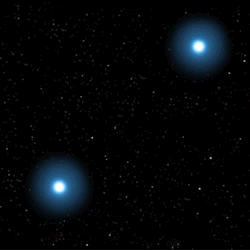Collisions of white dwarfs create objects that contain rare isotopes of oxygen and are poor in hydrogen
Pictured: Simulation of white dwarfs colliding and turning them back into a star
 Of all the stars in the Shalon galaxy, two types: low-hydrogen stars and R Coronae Borealis are extremely rare. Only a few decades of them have been discovered in the entire galaxy. And unlike most stars, they have almost no hydrogen, instead they contain huge amounts of a rare isotope of oxygen.
Of all the stars in the Shalon galaxy, two types: low-hydrogen stars and R Coronae Borealis are extremely rare. Only a few decades of them have been discovered in the entire galaxy. And unlike most stars, they have almost no hydrogen, instead they contain huge amounts of a rare isotope of oxygen.
What might be the origin of these strange objects? An international team of astronomers believes that colliding white dwarfs are to blame for the nature of these stars. A white dwarf is the expected fate of our sun. After it consumes its hydrogen reserves, the stars switch to helium and then they swell up and become red giants, but once they consume the helium, they no longer have enough mass to move up the chain to carbon. Instead, they collapse back into small dim objects called white dwarfs. Over the next 25 billion years they will slowly cool until they reach the temperature of the universe around them.
However, if two white dwarfs collide, they can create a new cloud of gas that will be hot enough to start the nuclear reaction process. Two dead stars can have another round of nuclear fusion and become a supergiant again, but instead of hydrogen they will consume heavier atoms. A paper on the subject, which relied on observations made using the Gemini Observatory in Hawaii, was presented at the American Astronomical Society meeting held this week in Seattle.
For information on the Gemini Observatory website
